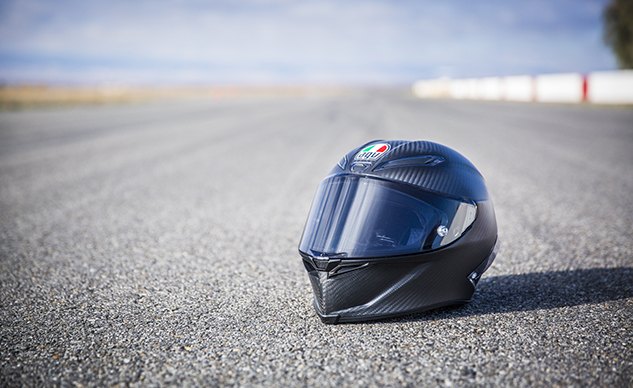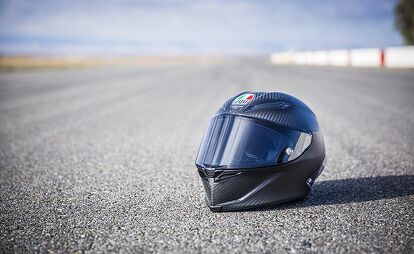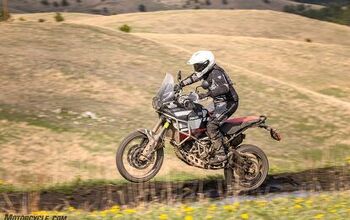AGV Corsa R Helmet: First Impressions

AGV's premier track helmet tested in its natural environment
When it comes to AGV helmets, it doesn’t get any higher than the Pista GP R and Corsa R helmets. AGV bills the former as the MotoGP helmet – the exact same one Valentino Rossi wears – while the latter is considered the company’s “Ultimate Track Helmet.” Of course, when you’re talking about flagship products from premier brands, you’re also talking mega bucks. So let’s get that out of the way now: The Pista GP R starts at a staggering $1,399.95, ramping up to an even more jaw dropping $1,599.95 for the Rossi and Andrea Iannone replica colorways. The Corsa R is just a smidge more reasonable, its starting price is $799.95, capped off with the $999.95 price tag for the Rossi Goodwood replica.
Sure you might scoff, or even choke, when you see those prices, but what makes these helmets so expensive is a combination of fit, finish, design and attention to detail. To make a broad statement on helmets, the lower down the price chain you go, the higher your chances one or more of those qualities will suffer. As AGV’s top two racing lids, what better place than a racetrack to test them out. Buttonwillow Raceway, in this case. There was a slight catch, however. Since the assembled journos aren’t scheduled to line up on the MotoGP grid next year, AGV only brought a couple Pista GP R models to look at. We’d be riding in the Corsa R. But to better understand the Corsa, we need to start with the Pista.
Built for Valentino
With its sole purpose being the ultimate helmet for racing and racers, the Pista GP R was developed with the help of AGV’s star child Valentino Rossi with three tenets in mind: protection, performance, and comfort. Yes, that’s what all the helmet manufacturers say, and the reputable ones achieve it in different ways. Here’s AGV’s approach.
First off, the Pista GP R shell is constructed entirely of carbon fiber (not just a carbon outer layer like some other companies) for ultimate weight savings. More importantly, each of its four available shell sizes receives its own dedicated EPS liner for supreme fit and comfort. There are seven sizes, from XS to XXL, including MS (medium-small) and ML (medium-large), the former getting its own dedicated shell while the latter shares its shell with the standard L helmet.
The Pista GP R comes equipped with a long, dual-plane rear spoiler to help reduce turbulence behind the rider’s head. Computational Fluid Dynamic (CFD) simulation software was used in conjunction with wind-tunnel testing for aerodynamic purposes, not only to slice the cleanest hole through the air – AGV claims a 4% aero improvement over the Pista GP – but also to help keep the rider’s head stable even while turning their heads at high speed. In the event of a crash, the spoiler is designed to snap off easily.
Speaking of crashes, the GP R sees a revision to its interior, with cheekpads that can be easily pulled away by emergency personnel to aid in helmet removal. As far as fit and comfort go, the Shalimar liner is both comfortable to the touch and wicks away sweat. The patented liner system features two “rabbit ears” that essentially wrap the crown of the head and can be adjusted a few degrees from side to side to better suit the rider’s preferences.
A notable difference between the Pista GP R and its Pista GP (no R) predecessor is its improved eye port. Now offering a 190º horizontal, and 85º vertical field of view, the latter is 15º better than before. AGV’s Race 2 visor is a robust 5mm thick and features a double anti-fog coating, as well as the new-and-improved Pinlock 120 insert. Unlike previous Pinlock inserts that only cover, say, 85% of the visor, the Pinlock 120 on the Pista GP R covers 100% of the visor’s viewable area. As for the 120, this stands for the minimum number of seconds one can breathe inside the helmet at a standstill before the insert starts to fog. The previous iteration was a Pinlock 70.
Other various detail touches of the Pista GP R include metal top vents, scooped and elongated chin vents to help draw in more air, a revised channeling system within the chin vents to disperse air across more of the face, a revised and recessed visor closure system for smoother operation and to help prevent accidental openings in the event of a crash. Lastly, the Pista GP R comes with an integrated hydration system. A world first, says AGV. The Pista GP R will be available February 1.
The Helmet For The Rest Of Us
Now that you know about the Pista GP R, the Corsa R is easier to explain. It’s like the fraternal twin to the Pista, except instead of carbon fiber, its shell is constructed from a carbon, kevlar and fiberglass composite, making it slightly less expensive. Also, the Biplano rear spoiler seen on the Pista GP R is gone, replaced with a more sensible, though slightly elongated, rear spoiler. Lastly, the Corsa R doesn’t see the scooped chin vents its MotoGP brother has, nor does it get the hydration system.
Otherwise, the two helmets are identical. There are still four shell sizes and four EPS liners, the 5mm visor with Pinlock 120 insert is the same, as is the visor locking mechanism, cheekpad safety release system, and chin vent channels. In fact, AGV reps say the Corsa R is slightly lighter than the Pista GP R due to the latter’s hydration system, though official numbers weren’t available.
The Corsa R isn’t just a toned down version of the Pista GP R, though. It boasts a 29% dB reduction compared to the previous Corsa thanks to an improved neck roll, though I’ve never sampled the Corsa to corroberate these claims. Also the Corsa R is the first helmet with a patented, reversible crown pad, featuring a warm or cool side to suit the weather conditions and rider preference. The warm side features Shalimar fabric that I’d say resembles the feel of suede, while the cool side is Ritmo fabric that loosely mimics the feel of your cotton bed sheets. Both sides wick away sweat and have anti-microbial properties, and are of course machine washable.
As for riding dynamics, the Corsa R is intended for intermediate-oval heads that represent most of the European and American markets (AGV says there’s an option for the rounder head shapes of the Asian market), and with the adjustable bunny ears in the liner, the rider can fine-tune the position the helmet sits on their heads. I didn’t have to adjust anything on my lid, feeling the standard position was just fine. The fit is tight and close to my face, with minimal yet robust padding across my cheeks and forehead – exactly what I want from a racing/track helmet. And this coming from a guy who’s had mixed luck with AGV helmets fitting me correctly. It’s not uncomfortable, but it’s also not a helmet I’d want to wear for an extended touring ride, either.
Double D-rings provide a secure closure and the snap at the end ensures the excess strap doesn’t distract the rider. I really dig the fact the visor glides smoothly across its travel, like an Arai, and the spring-loaded closure system engages positively and securely every time. It’s now my favorite shield-closure system on the market. A slight press of the button will crack the shield open slightly if you need more airflow. The shield changing mechanism itself is also simple, allowing changes to be made regardless of shield position.
With the shield down and the motorcycle moving, three things were immediately clear: The wide field of vision is real, not marketing hype; the vents flow a tremendous amount of air; and the Corsa R feels light on my head, almost as if I wasn’t wearing a helmet at all. Those attributes, combined with the comfortable fit, gave me a very positive initial impression.
My view was solidified after turning my head aboard the naked EBR 1190SX I rode at the track. Without the help of fairings or windscreens to redirect airflow, I expected my head to buffet once I turned. Nope. No buffeting. Not even a strain to turn my neck back in the forward direction. I can’t say other race/track helmets I’ve tried in the past would have done the same.
If It’s Good Enough For Rossi…
On one hand, I’m extremely impressed with the Corsa R. It’s a fantastic helmet for the hardcore race or track enthusiast, with all the features that allow it to move to your subconscious while you focus on the business of setting your best lap time. However, for the price, it better be that good. I’d be disappointed if any facet of the helmet let me down. Even a little.
It’s hard to put a price on your personal safety. If money is no object, which might be the case if you can afford to race, then the decision is simple. Otherwise, subscribe to the theory of ignorance being bliss in the world of helmets and don’t try on the Corsa R (or especially the Pista GP R). Once you do, you might consider selling a kidney to afford one.

Troy's been riding motorcycles and writing about them since 2006, getting his start at Rider Magazine. From there, he moved to Sport Rider Magazine before finally landing at Motorcycle.com in 2011. A lifelong gearhead who didn't fully immerse himself in motorcycles until his teenage years, Troy's interests have always been in technology, performance, and going fast. Naturally, racing was the perfect avenue to combine all three. Troy has been racing nearly as long as he's been riding and has competed at the AMA national level. He's also won multiple club races throughout the country, culminating in a Utah Sport Bike Association championship in 2011. He has been invited as a guest instructor for the Yamaha Champions Riding School, and when he's not out riding, he's either wrenching on bikes or watching MotoGP.
More by Troy Siahaan
















































































Comments
Join the conversation
Hey Trizzle,
We can't tell from this photo. Are you still sporting those mutton chops?
http://motorcycle.com.vsass...
Why is the lead image an AGV Pista GP-R when the article's titled: AGV Corsa R Helmet: First Impressions? The subtitle: AGV’s premier track helmet tested in its natural environment also implies only one helmet was tested, but AGV's "premier track helmet" would be the Pista GP-R...